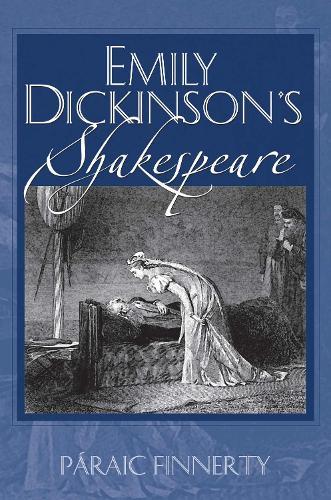Overview
This book tells how Dickinson's fascination with Shakespeare informed her life and her poetry. One of the messages that Emily Dickinson wanted to communicate to the world was her great love of William Shakespeare - her letters abound with references to him and his works. This book explores the many implications of her admiration for the Bard.Paraic Finnerty clarifies the essential role that Shakespeare had in Dickinson's life by locating her allusions to his writings within a nineteenth-century American context and by treating reading as a practice that is shaped, to a large extent, by culture. In the process, he throws new light on Shakespeare's multifaceted presence in Dickinson's world: in education, theater, newspapers, public lectures, reading clubs, and literary periodicals.Through analysis of letters, journals, diaries, records, periodicals, newspapers, and marginalia, Finnerty juxtaposes Dickinson's engagement with Shakespeare with the responses of her contemporaries. Her Shakespeare emerges as an immoral dramatist and highly moral poet; a highbrow symbol of class and cultivation and a lowbrow popular entertainer; an impetus behind the emerging American theater criticism and an English author threatening American creativity; a writer culturally approved for women and yet one whose authority women often appropriated to critique their culture. Such a context allows the explication of Dickinson's specific references to Shakespeare and further conjecture about how she most likely read him.Finnerty also examines those of Dickinson's responses to Shakespeare that deviated from what might have been expected and approved of by her culture. Imaginatively departing from the commonplace, Dickinson chose to admire three of Shakespeare's most powerful and transgressive female characters - Cleopatra, Queen Margaret, and Lady Macbeth - instead of his more worthy and virtuous heroines. More startling, although the poet found resonance for her own life in Hamlet, Romeo and Juliet, and Macbeth, she chose, in the racially charged atmosphere of nineteenth-century America, to identify with Shakespeare's most controversial character, Othello, thereby defying expectations once again.
Full Product Details
Author: Paraic Finnerty
Publisher: University of Massachusetts Press
Imprint: University of Massachusetts Press
Dimensions:
Width: 16.00cm
, Height: 2.00cm
, Length: 23.40cm
Weight: 0.447kg
ISBN: 9781558496705
ISBN 10: 155849670
Pages: 280
Publication Date: 30 September 2008
Audience:
Professional and scholarly
,
Professional and scholarly
,
Professional & Vocational
,
Professional & Vocational
Format: Paperback
Publisher's Status: Active
Availability: In Print

This item will be ordered in for you from one of our suppliers. Upon receipt, we will promptly dispatch it out to you. For in store availability, please contact us.
Reviews
Finnerty's well-researched and accessible volume should interest both scholars and general readers. Finnerty has an uncommonly even-handed way of showing how Dickinson both participated in standard conventional practices and responded brilliantly and idiosyncratically to Shakespeare's. Emily Dickinson's Shakespeare is much more than a source study, though it is that in passing. It amounts to a cultural biography of Dickinson--a biography of her shifting yet enduring imagination. It includes a good deal of American cultural history as well.... This is a very fine book, written with scholarly skills that seem to belong to an earlier era and with a cultural, psychological, and historical savvy that very much belongs to the present moment. Emily Dickinson's Shakespeare is beautifully researched, absorbing in its critical narrative, and a joy to read.
Emily Dickinson's Shakespeare is much more than a source study, though it is that in passing. It amounts to a cultural biography of Dickinson--a biography of her shifting yet enduring imagination. It includes a good deal of American cultural history as well. . . . This is a very fine book, written with scholarly skills that seem to belong to an earlier era and with a cultural, psychological, and historical savvy that very much belongs to the present moment. Emily Dickinson's Shakespeare is beautifully researched, absorbing in its critical narrative, and a joy to read.--Emily Dickinson Journal Pariac Finnerty amply demonstrates that Emily Dickinson, along with her entire cultural milieu, was fully saturated with Shakespeare. . . . Finnerty has an uncommonly evenhanded way of showing how Dickinson both participated in standard conventional practices and responded brilliantly and idiosyncratically to Shakespeare's.--New England Quarterly Finnerty's well-researched and accessible volume should interest both scholars and general readers.--Emily Dickinson International Society Bulletin . . . a well-researched, carefully organized, and altogether engrossing book. Finnerty examines Dickinson's Shakespeare from a wide variety of perspectives - cultural, psychological, literary. It would be difficult to imagine a more completely realized study of the American poet and the English bard.--Emily Dickinson International Society Bulletin
Emily Dickinson's Shakespeare is much more than a source study, though it is that in passing. It amounts to a cultural biography of Dickinson--a biography of her shifting yet enduring imagination. It includes a good deal of American cultural history as well.... This is a very fine book, written with scholarly skills that seem to belong to an earlier era and with a cultural, psychological, and historical savvy that very much belongs to the present moment. Emily Dickinson's Shakespeare is beautifully researched, absorbing in its critical narrative, and a joy to read.
Author Information
PARAIC FINNERTY received his PhD from the University of Kent. He is a lecturer in English literature at the University of Portsmouth, England.




